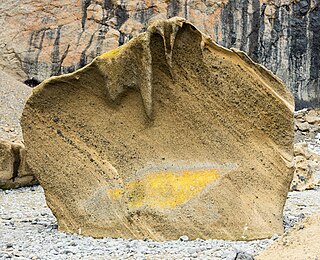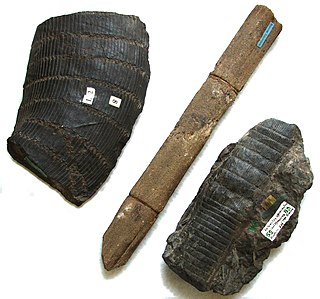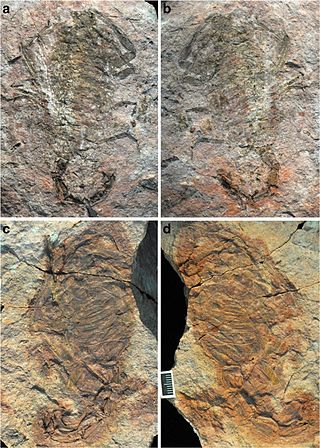
Petrified wood, is the name given to a special type of fossilized wood, the fossilized remains of terrestrial vegetation. Petrifaction is the result of a tree or tree-like plants having been replaced by stone via a mineralization process that often includes permineralization and replacement. The organic materials making up cell walls have been replicated with minerals. In some instances, the original structure of the stem tissue may be partially retained. Unlike other plant fossils, which are typically impressions or compressions, petrified wood is a three-dimensional representation of the original organic material.

Tephra is fragmental material produced by a volcanic eruption regardless of composition, fragment size, or emplacement mechanism.

Calamites is a genus of extinct arborescent (tree-like) horsetails to which the modern horsetails are closely related. Unlike their herbaceous modern cousins, these plants were medium-sized trees, growing to heights of 30–50 meters. They were components of the understories of coal swamps of the Carboniferous Period.

Calamitaceae is an extinct family of equisetalean plants related to the modern horsetails, known from the Carboniferous and Permian periods. Some members of this family like Arthropitys attained tree-like stature, with heights over 15 metres (49 ft), with extensive underground rhizomes. They were largely found in wetland environments.

Eupelycosauria is a large clade of animals characterized by the unique shape of their skull, encompassing all mammals and their closest extinct relatives. They first appeared 308 million years ago during the Early Pennsylvanian epoch, with the fossils of Echinerpeton and perhaps an even earlier genus, Protoclepsydrops, representing just one of the many stages in the evolution of mammals, in contrast to their earlier amniote ancestors.

Caseasauria is one of the two main clades of early synapsids, the other being the Eupelycosauria. Caseasaurs are currently known only from the Late Carboniferous and the Permian, and include two superficially different families, the small insectivorous or carnivorous Eothyrididae, and the large, herbivorous Caseidae. These two groups share a number of specialised features associated with the morphology of the snout and external naris.
Varanopidae is an extinct family of amniotes known from the Late Carboniferous to Middle Permian that resembled monitor lizards and may have filled a similar niche. Typically, they are considered to be relatively basal synapsids, although some studies from the late 2010s recovered them being taxonomically closer to diapsid reptiles, recent studies from the early 2020s support their traditional placement as synapsids on the basis of high degree of bone labyrinth ossification, maxillary canal morphology and phylogenetic analyses. A varanopid from the latest Middle Permian Pristerognathus Assemblage Zone is the youngest known varanopid and the last member of the "pelycosaur" group of synapsids.

Psaronius is an extinct genus marattialean tree fern which grew to 10m in height, and is associated with leaves of the organ genus Pecopteris and other extinct tree ferns. Originally, Psaronius was a name for the petrified stems, but today the genus is used for the entire tree fern. Psaronius tree fern fossils are found from the Carboniferous through the Permian.

Asaphestera is an extinct genus of a synapsid described on the basis of fossils from the Carboniferous of the Joggins locality in Nova Scotia, Canada. It was originally described as an undetermined lepospondyl and subsequently classified as a microsaur within the family Tuditanidae. A study published in May 2020 found that specimens referred to Asaphestera represented several unrelated species. Steen (1934)'s original species name Asaphestera platyris was retained for a skull which has been re-evaluated as the earliest known synapsid.

Mesenosaurus is an extinct genus of amniote. It belongs to the family Varanopidae. This genus includes two species: the type species Mesenosaurus romeri from the middle Permian Mezen River Basin of northern Russia, and Mesenosaurus efremovi from the early Permian (Artinskian) Richards Spur locality. M. romeri’s stratigraphic range is the middle to late Guadalupian while M. efremovi’s stratigraphic range is the Cisuralian.

Heleosaurus scholtzi is an extinct species of basal synapsids, known as pelycosaurs, in the family of Varanopidae during the middle Permian. At first H. scholtzi was mistakenly classified as a diapsid. Members of this family were carnivorous and had dermal armor, and somewhat resembled monitor lizards. This family was the most geologically long lived, widespread, and diverse group of early amniotes. To date only two fossils have been found in the rocks of South Africa. One of these fossils is an aggregation of five individuals.

Tietea was a genus of marattialean tree ferns from the Late Carboniferous to the Permian. The genus has been placed in a number of families, including Psaroniaceae. The first described species was Tietea singularis, which grew up to 12 metres (39 ft) in height. It is estimated to represent close to 90% of some fossil assemblages in Brazil. Tietea derbyi was described in 1992, but its validity has been questioned as it could be a laterally flattened specimen of T. singularis.

The Leukersdorf Formation is a geologic formation in Germany. It preserves fossils dating back to the lower Permian period. The Chemnitz petrified forest occurs within this formation, and fossils have been found in the Leukersdorf Formation since at least 1546.

Opsieobuthus is an extinct genus of centromachid scorpion. The type species O. pottsvillensis was named from the late Carboniferous of Clay City, Indiana. A second species ?O. tungeri was tentatively assigned to the genus from the Early Permian Chemnitz petrified forest in Germany.
Ascendonanus is an extinct genus of varanopid amniote from the Early Permian of Germany. It is one of the earliest specialized arboreal (tree-living) tetrapods currently known and outwardly resembled a small lizard. The animal was about 40 cm long, with strongly curved claws, short limbs, a slender, elongated trunk, and a long tail. It would have preyed on insects and other small arthropods.
Microvaranops is a Middle Permian synapsid of the family Varanopidae from the Abrahamskraal Formation of South Africa. It includes one species, Microvaranops parentis, which was probably arboreal. A slab containing five specimens of Microvaranops indicates that it gathered or lived in groups.

Arthropitys is an extinct genus of calamitacean equisetale. The petrified fossils of Arthropitys bistriata, the type species, can be found in the Leukersdorf Formation, Chemnitz petrified forest, Chemnitz, Germany. The genus existed from the Carboniferous (Bashkirian) until the Early Triassic (Olenekian).
Dendromaia is an extinct genus of varanopid from the Carboniferous of Nova Scotia. It contains a single species, Dendromaia unamakiensis. Dendromaia is the oldest known varanopid, the only member of which to be discovered in Nova Scotia. Known from a large partial skeleton preserved with its tail wrapped around a much smaller partial skeleton, Dendromaia may also represent the oldest known occurrence of parental care in the fossil record. While the larger skeleton possessed certain mycterosaurine-like features, the smaller skeleton resembled basal varanopids such as Archaeovenator and Pyozia, creating uncertainty over whether characteristics at the base of Varanopidae have legitimate phylogenetic significance or instead reflect the immaturity of basal varanopid specimens.
Anningia is an extinct genus in Varanopidae, a family of monitor lizard-like amniotes. It contains a single species, Anningia megalops.

Tridentinosaurus is a dubious genus of extinct fossil reptile from the early Permian Regnana Formation of the Italian Alps. The genus contains a single species, T. antiquus. Tridentinosaurus represents one of the oldest known vertebrate fossils found in Italy. The only parts of the skeleton that are preserved are the long bones of the hind limbs, and the supposed soft tissue body outline is a forgery done with paint, though some genuine scales may also be preserved. Due to the poor preservation of the limb bones, the validity of the taxon is questionable.

















